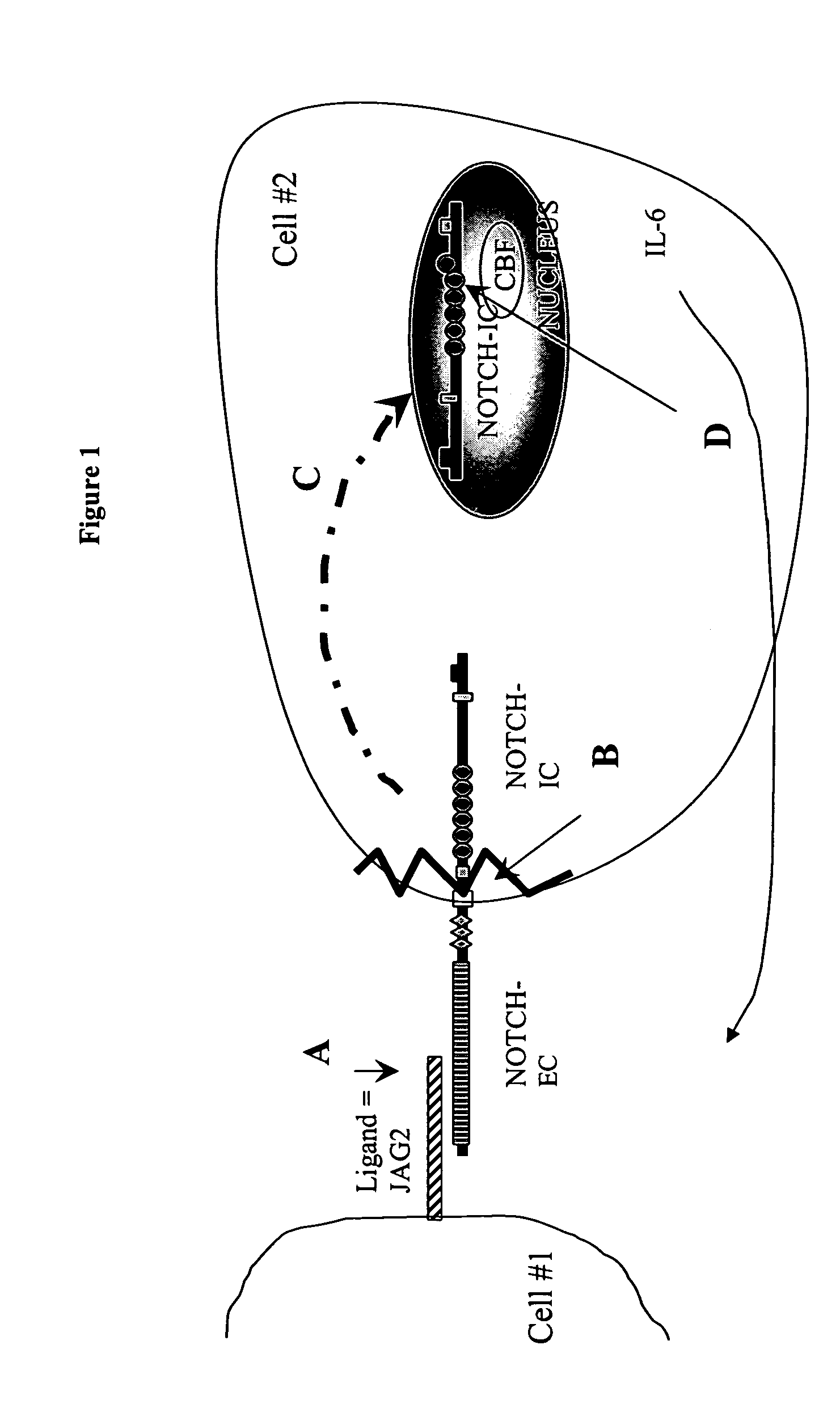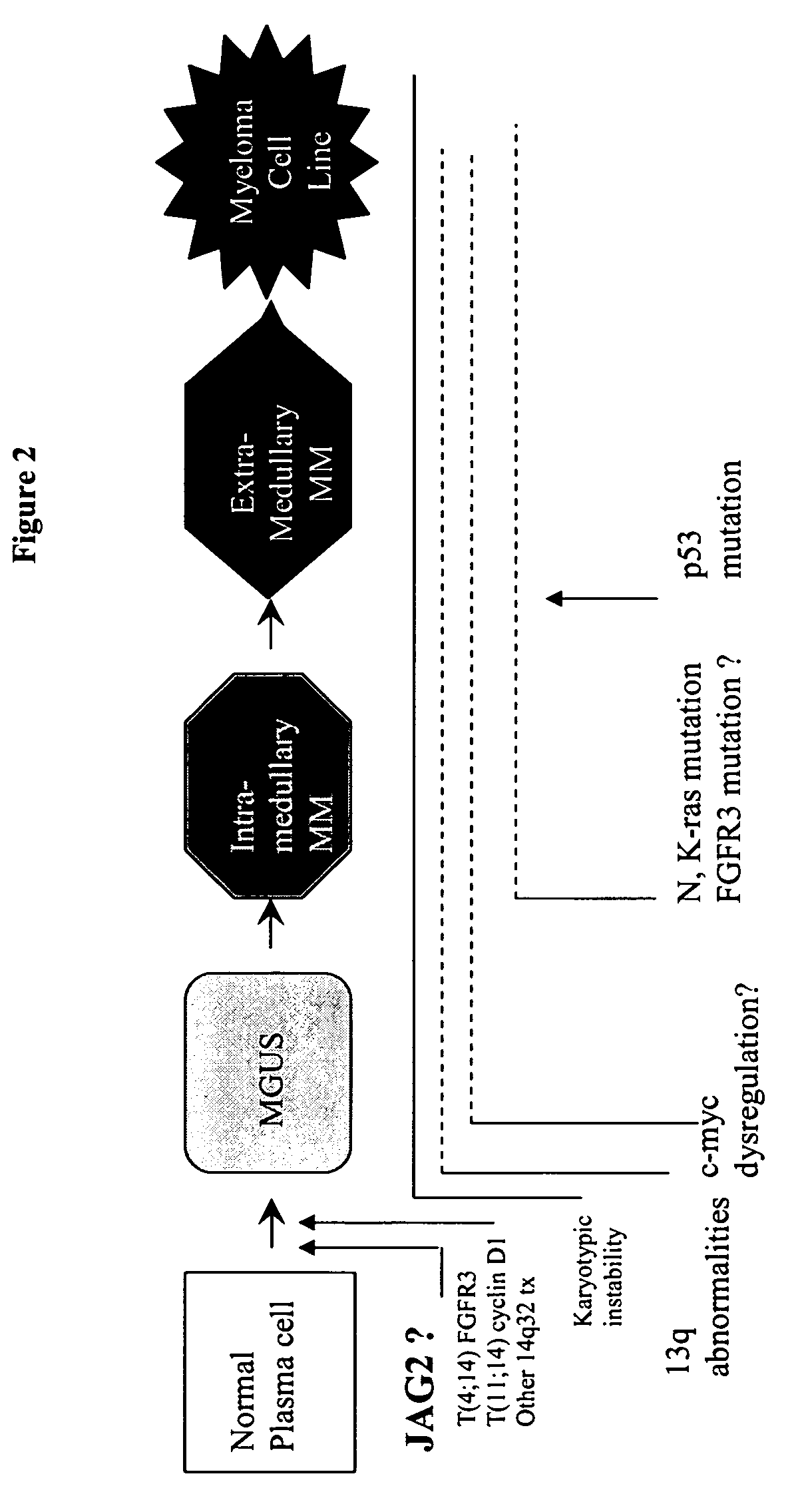Use of NOTCH pathway interfering agents for treatment of plasma cell disorders
a plasma cell disorder and notch pathway technology, applied in the direction of drug compositions, extracellular fluid disorders, antibody medical ingredients, etc., can solve the problems that the treatment used in this disease only allowed limited efficacy in treating the disease, and the disease remains incurable, so as to and reduce the severity of plasma cell disorders
- Summary
- Abstract
- Description
- Claims
- Application Information
AI Technical Summary
Problems solved by technology
Method used
Image
Examples
example 1
[0034]This embodiment demonstrates that IL-6 secretion is elicited by MM cells. In order to demonstrate that IL-6 secretion is a direct consequence of JAG2 over-expression in the MM context, we developed a co-culture in vitro assay using fibroblast cells and our multiple myeloma cell lines (that over-express JAG2 as already shown). We used the MRC5 fibroblast cell line as a feeder layer in these experiments. Culture wells were seeded with MRC5 cells. Upon 70% confluence, the cells were irradiated to stop their growth. Culture medium was collected for MRC5 cells cultured alone, co-cultured with a MM cell line or co-cultured with a MM cell line but separated from them by an insert, avoiding cell contacts between the two cell types. IL-6 levels were assayed on the culture medium. As shown in FIG. 4, the co-culture of MRC5 and the MM cell line induced a 3.5-fold increase in IL-6 secretion whereas the same co-culture without contact between the two cell types only marginally affected IL-...
example 2
[0035]In this embodiment, an anti-NOTCH1 monoclonal antibody was used to block the NOTCH pathway. This antibody (A6) has been raised against NOTCH1 peptide and is considered to block the binding of JAG2 to NOTCH1 (FIG. 3). The assay was similar to one described in Example 1. MRC5 cells were co-cultured with the myeloma cell line in the presence of an increasing amount of anti-NOTCH1 monoclonal antibody (5, 10, 20, 40 μM). The results of these experiments (FIG. 5A) show that when the monoclonal antibody was added to the cultures, IL-6 release was reduced. Furthermore, the reduction in the IL6 release from the fibroblasts was proportional to the amount of monoclonal antibody added to the culture medium, showing that this agent was able to block the release in a specific manner. Thus, by blocking NOTCH activation, the release of IL6 induced by the contact between the 2 cell types is reduced. A similar effect of increased secretion of IL-6 was seen when MRC5 cells were co-cultured with ...
example 3
[0036]In this example, SCID mice were used to demonstrate the effect of interference with the NOTCH pathway in vivo. SCID-Hu mice were obtained as follows. 19-23 weeks old human fetal bones were obtained from the Birth Defects Laboratory, University of Washington, Seattle, Wash. These long fetal bones were implanted sub-cutaneously in CB17 SCID mice. Seven frozen MM patient samples were injected in the fetal bone from different SCID mice (after light irradiation) and levels of human Ig were monitored to assess the development of subsequent MM in the fetal bone. Mice with transplanted fetal bone but without MM sample injected were used as controls. Blood serum was obtained from the mice through-eye bleeds and Ig levels were assessed by ELISA assay. Ig was detected in five out of seven mice, corresponding to five different MM samples. In addition, we could document the bone disease induced by the proliferation of the MM in the fetal bone.
[0037]The anti-NOTCH1 MAb was used in the model...
PUM
| Property | Measurement | Unit |
|---|---|---|
| concentration | aaaaa | aaaaa |
| affinity | aaaaa | aaaaa |
| time | aaaaa | aaaaa |
Abstract
Description
Claims
Application Information
 Login to View More
Login to View More - R&D
- Intellectual Property
- Life Sciences
- Materials
- Tech Scout
- Unparalleled Data Quality
- Higher Quality Content
- 60% Fewer Hallucinations
Browse by: Latest US Patents, China's latest patents, Technical Efficacy Thesaurus, Application Domain, Technology Topic, Popular Technical Reports.
© 2025 PatSnap. All rights reserved.Legal|Privacy policy|Modern Slavery Act Transparency Statement|Sitemap|About US| Contact US: help@patsnap.com



